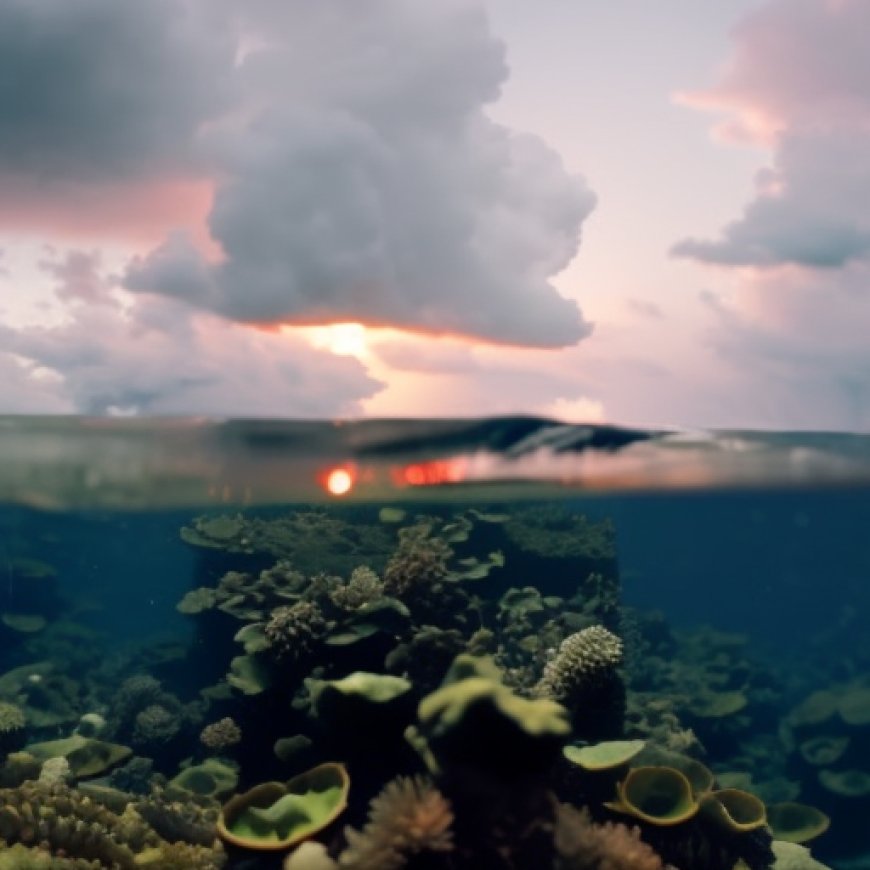Climate change has significantly changed the color of the ocean – study
Climate change has significantly changed the color of the ocean ... The Jerusalem Post


Climate Change Impact on Ocean Color
According to a recent study conducted by researchers from the UK and the US, climate change has significantly altered the color of the ocean over the past two decades. The study, published in the peer-reviewed journal Nature, highlights that more than 56% of the world’s oceans have experienced color changes that cannot be attributed solely to natural variations.
Research Methodology
The researchers utilized NASA’s Moderate Resolution Imaging Spectroradiometer (MODIS) on the Aqua satellite to analyze ocean color measurements from 2002 to 2022. They examined the seven colors measured by the satellite and observed their natural variations on a regional and global scale over the two-decade period.
Findings and Implications
The study revealed that tropical ocean regions near the equator have become progressively greener, indicating a shift in ecosystems within the water. The color changes are primarily driven by alterations in plankton communities, as deep blue waters tend to have limited life in their upper layers, while greener waters signify the presence of ecosystems and phytoplankton containing chlorophyll.

Bioluminescent phytoplankton is seen along the coastal waters at Big Sur, California, US, February 6, 2018. (credit: George Krieger/Handout via REUTERS )
Although the exact impact of these color changes on marine ecosystems remains uncertain, the researchers believe that human-induced climate change is the most likely cause. By comparing their findings to a model developed by study co-author Stephanie Dutkiewicz in 2019, the researchers confirmed that the observed changes align closely with the model’s predictions.
Accelerated Changes and Implications
The National Oceanography Center noted that the detection of significant color changes within a span of 20 years is noteworthy. Previously, it was believed that 30 years of satellite data would be required to identify trends in chlorophyll related to climate change. This study provides additional evidence of how human activities are impacting life on Earth on a global scale.
Lead author B. B. Cael PhD ’19 from the National Oceanography Center in Southampton, UK, emphasized the importance of these findings, stating, “It’s another way that humans are affecting the biosphere.”
Stephanie Dutkiewicz further emphasized the implications of the color changes, stating, “Changes in color reflect changes in plankton communities, which will impact everything that feeds on plankton. It will also change how much carbon the ocean absorbs, as different types of plankton have varying abilities to do so. We hope people take this seriously because we can now see these changes happening, and the ocean is changing.”
SDGs, Targets, and Indicators
| SDGs | Targets | Indicators |
|---|---|---|
| SDG 13: Climate Action | Target 13.1: Strengthen resilience and adaptive capacity to climate-related hazards and natural disasters | Indicator: Changes in ocean color as a result of climate change |
| SDG 14: Life Below Water | Target 14.1: By 2025, prevent and significantly reduce marine pollution of all kinds, particularly from land-based activities, including marine debris and nutrient pollution | Indicator: Changes in ocean color as an indication of changes in plankton communities |
| SDG 14: Life Below Water | Target 14.3: Minimize and address the impacts of ocean acidification, including through enhanced scientific cooperation at all levels | Indicator: Changes in ocean color as a reflection of changes in the ability of plankton to take up carbon |
1. Which SDGs are addressed or connected to the issues highlighted in the article?
SDG 13: Climate Action
The article discusses how climate change has likely caused significant changes in the color of the ocean over the past 20 years. This directly connects to SDG 13, which focuses on taking urgent action to combat climate change and its impacts.
SDG 14: Life Below Water
The article highlights the changes in ocean color as a result of changes in plankton communities. This connects to SDG 14, which aims to conserve and sustainably use the oceans, seas, and marine resources for sustainable development.
2. What specific targets under those SDGs can be identified based on the article’s content?
Target 13.1: Strengthen resilience and adaptive capacity to climate-related hazards and natural disasters
The article emphasizes the changes in ocean color as evidence of climate change. This aligns with the target of strengthening resilience and adaptive capacity to climate-related hazards and natural disasters.
Target 14.1: By 2025, prevent and significantly reduce marine pollution of all kinds, particularly from land-based activities, including marine debris and nutrient pollution
Although not explicitly mentioned in the article, the changes in ocean color can be an indication of changes in plankton communities, which are affected by pollution and nutrient levels. This relates to the target of preventing and reducing marine pollution.
Target 14.3: Minimize and address the impacts of ocean acidification, including through enhanced scientific cooperation at all levels
The article mentions that changes in ocean color reflect changes in the ability of plankton to take up carbon. This connects to the target of addressing ocean acidification and enhancing scientific cooperation to minimize its impacts.
3. Are there any indicators mentioned or implied in the article that can be used to measure progress towards the identified targets?
The article mentions the changes in ocean color as a result of climate change and its impact on plankton communities. These changes can serve as indicators to measure progress towards the identified targets under SDGs 13 and 14.
4. Table: SDGs, Targets, and Indicators
| SDGs | Targets | Indicators |
|---|---|---|
| SDG 13: Climate Action | Target 13.1: Strengthen resilience and adaptive capacity to climate-related hazards and natural disasters | Indicator: Changes in ocean color as a result of climate change |
| SDG 14: Life Below Water | Target 14.1: By 2025, prevent and significantly reduce marine pollution of all kinds, particularly from land-based activities, including marine debris and nutrient pollution | Indicator: Changes in ocean color as an indication of changes in plankton communities |
| SDG 14: Life Below Water | Target 14.3: Minimize and address the impacts of ocean acidification, including through enhanced scientific cooperation at all levels | Indicator: Changes in ocean color as a reflection of changes in the ability of plankton to take up carbon |
Behold! This splendid article springs forth from the wellspring of knowledge, shaped by a wondrous proprietary AI technology that delved into a vast ocean of data, illuminating the path towards the Sustainable Development Goals. Remember that all rights are reserved by SDG Investors LLC, empowering us to champion progress together.
Source: jpost.com

Join us, as fellow seekers of change, on a transformative journey at https://sdgtalks.ai/welcome, where you can become a member and actively contribute to shaping a brighter future.







